This post may contain affiliate links. Please read our disclosure for more info.
Warrior I, or Virabhadrasana I, is a pose found in almost all yoga classes. From Vinyasa to Hatha, you will likely be practicing a Warrior pose on your mat. In Sanskrit, Vira translates to hero, warrior, and courageous. While blade translates to friend and asana translates to posture.
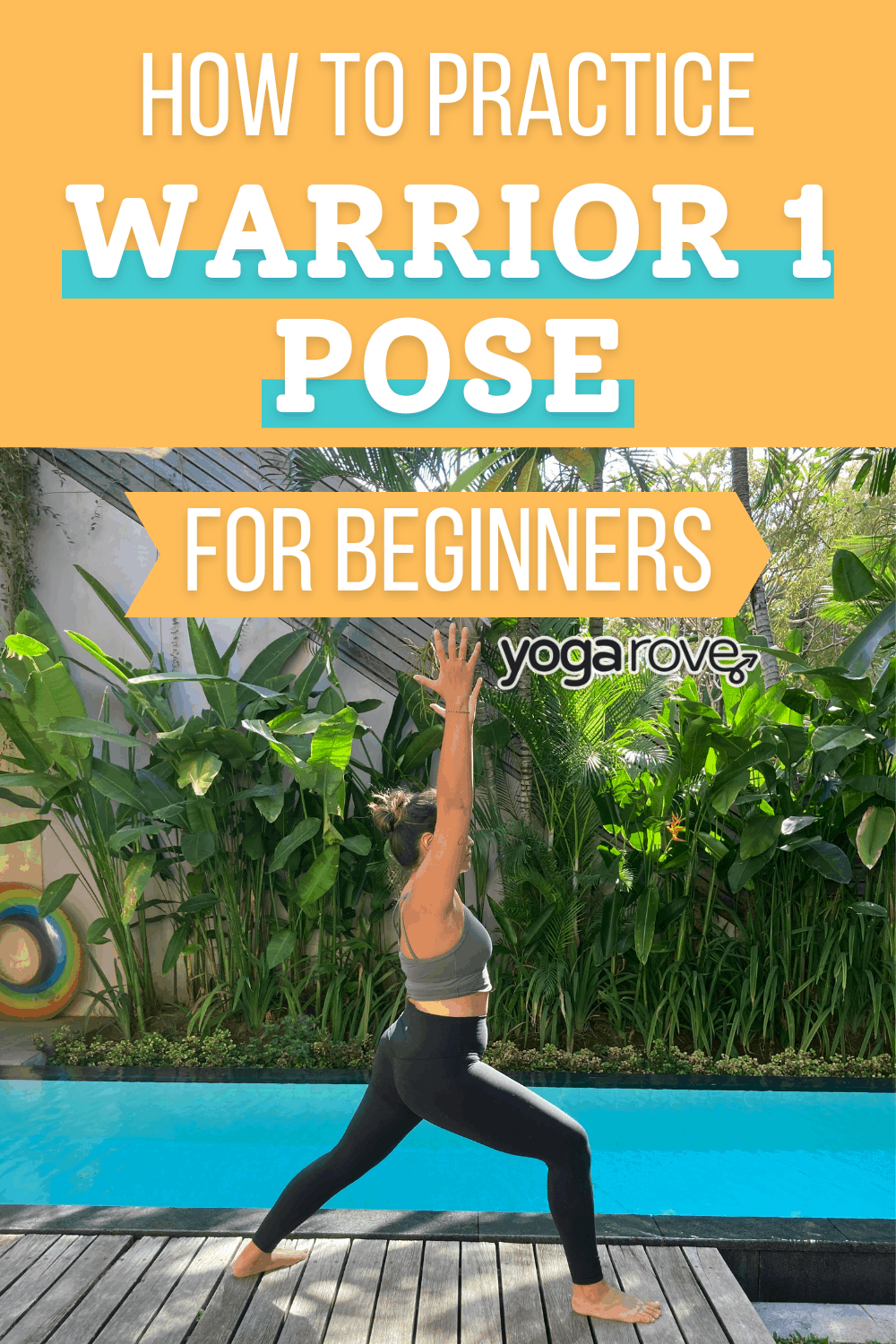
This is a pose to practice courageously, yet peacefully, while standing in your power. In the posture, you extend your arms up in a gesture of openness and courage. This powerful stance builds mental and emotional confidence, allowing you to connect to your inner strength to stand in your pose.
Benefits of Warrior 1 Pose
When you practice Warrior 1, you are imitating a strong warrior in a courageous stance. The posture itself is one of grounding, energy, and balance. Warrior I is an extremely rooting, stabilizing pose. It is effective for activating and balancing your root chakra, which is the center of stability in your life.
Some benefits of Warrior 1 pose are:
- Improves circulation
- Grounds and energizes you
- Strengthens upper and lower body
- Activates your core strength
- Stretches your chest, hips, hamstrings, and quads
- Builds strength and confidence
Warming Up for Warrior 1 Pose
A standing pose, Warrior 1 is often practiced during the middle of your yoga class. If you are taking a Vinyasa or Hatha class, you will likely have a warm-up, a few rounds of Sun Salutations, and then you will make your way into standing yoga postures.
Before you practice Warrior 1, it is a good idea to warm up your entire body. Your yoga teacher will lead you through a warm-up to activate your muscles and fire up the ones that you need for Warrior 1.
Here are some poses that are great to warm up with:
- Sun Salutation: Made up of a few yoga poses, 2-5 rounds of a Sun Salutation will open your body right up. Often, Sun Salutations are followed up with Sun Salutation B, where a Warrior 1 is taken on each side.
- Mountain Pose: Part of a Sun Salutation, Mountain pose helps you to feel grounded and strong on both of your feet. Work on activating your lower body by pulling your kneecaps up and squeezing your thigh muscle to the bone. Feel everything squeeze toward the midline of your body and focus on these same aspects in your Warrior 1.
- Tree Pose: This pose will activate your legs and open up your hips. Standing on one leg allows you to feel grounded and find stability. Use this same action in your Warrior 1, even though you are balancing on two feet.
How to Practice Warrior 1 Pose
Root down and find your center with Warrior 1. This pose allows you to feel grounding energy in your lower body and helps to build strength and stability in your entire body.

To practice Warrior 1 pose:
- From downward-facing dog, step your right foot forward in between your hands.
- Root your left heel down to the floor with your toes pointing slightly inward at a 45-degree angle.
- Keep your right knee bent at a 90-degree angle. Make sure that your knee is not over your ankle.
- Lift your upper body up and take your arms up overhead.
- Roll your left hip slightly forward and your right hip slightly back.
- Stack your shoulders on top of your hips and lift your upper body out of your waist.
- Keep your arms strong and take your palms together or facing each other.
- Lift your chest and relax your shoulders away from your ears.
- Root your feet down to the mat as you keep your legs strong and your upper body lifted.
- Gaze forward or look up toward your prayer hands.
Common Misalignments
While Warrior 1 is very common to practice in class, it is also very common to practice it without the proper alignment. Before you find yourself going deeper into the posture, make sure to check your alignment and make that your priority in the pose.
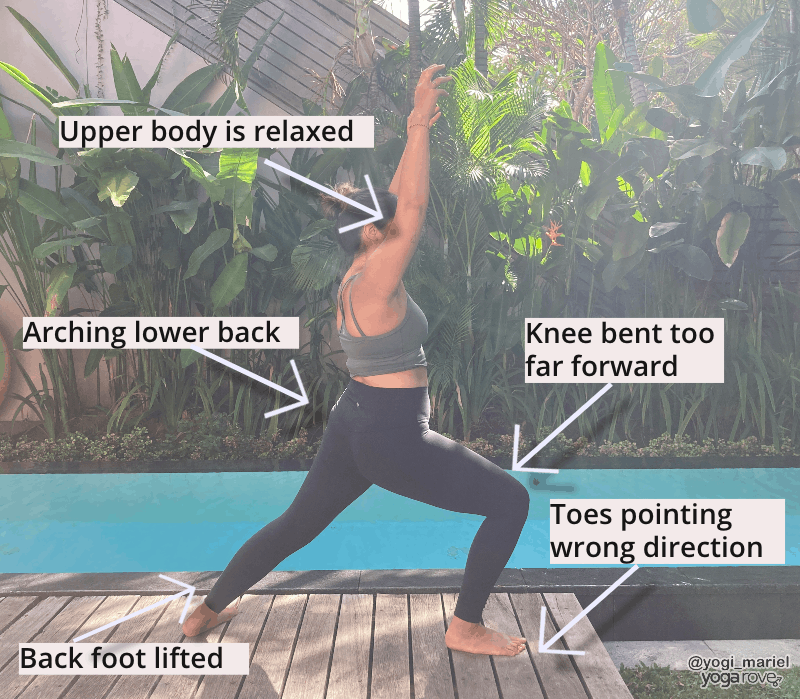
Some common misalignments in Warrior 1 are:
- Front toes pointing the wrong direction: Your front foot should be pointing toward the front of the room so that it’s parallel with the long edge of your mat. Check that your toes are pointing straight forward instead of turning inward or outward.
- Your front knee is bent too far forward: Your knee should be directly in line with the ankle, forming a 90-degree angle, or as much as feels comfortable. If your knee if too far forward, your stance may be too short. Step your back leg a few inches back and ground down with your back foot.
- Lifting your back foot: Your back foot is your foundation. Make sure that you feel steady and strong by rooting down with your back heel and your toes. Your back toes should be turned in at a 45-degree angle, making it easier to root down and activate your leg muscles. If it is challenging to root your foot down, take your foot a few inches forward. Focus on keeping your foot rooted and your legs strong.
- Arching your lower back: Check that you are engaging your core and stacking your shoulders directly over your hips. Often, yogis arch the lower back which can cause pain and injury. Think of drawing your belly button in toward your spine and hugging your ribs inward.
- Relaxed upper body: Though it may feel like most of the work is happening in your lower body, don’t forget about your upper body! Keep your arms strong, chest open, ribs in, and core tight. At the same time, make sure that you relax your shoulders, keep your gaze soft, and soften your neck.
Modifications
If you have tight hips or knee pain, Warrior 1 may feel a little extra challenging to practice. There are many modified variations that you can practice and still receive the benefits of the pose.

Support your back foot: It may be challenging to root your back foot down to the mat. If so, use a prop! Roll a blanket up, use a block, or use a small bolster to push your foot against. This will encourage you to fire up your leg muscles and find that grounding feeling.
Keep your hands low: If you notice shoulder, neck, or upper body tension when you raise your arms up, keep them down. You can place them either on your hips or place them at your heart center.
Find your perfect stance and distance: Depending on your body, you may have to shorten or widen your stance to find comfort in the posture. If you have back pain, try to widen your stance a little.
Use a wall: If it is challenging to find your balance, practice Warrior 1 near a wall. Come into the pose and place the hand closest to the wall gently on the wall. You can lift your other arm up, or place your hand on your hip. Focus on finding a grounding feeling with your lower body and feel lightness in your upper body.
Tips for Beginners
- Modify: Never feel as if you need to come into the full expression of the pose. Always listen to your body and take whatever modifications feel necessary, whether it’s a block or an adjustment of your feet.
- Feel the pose in your body: Use the posture to become more aware of the physical sensations in your body. Does your back leg feel grounded? Are you arching your back? The more that you can become in tune with these sensations, the easier it is to adjust and ground yourself in the pose.
- Take your time: Everyone has different experiences and different bodies. There is no ‘right’ way to look or a certain amount of time that you need to ‘get’ the posture. Take your time and enjoy the journey.
Variations in Warrior 1 Pose
There are tons of variations of this strong posture that you can try. Here are a few:
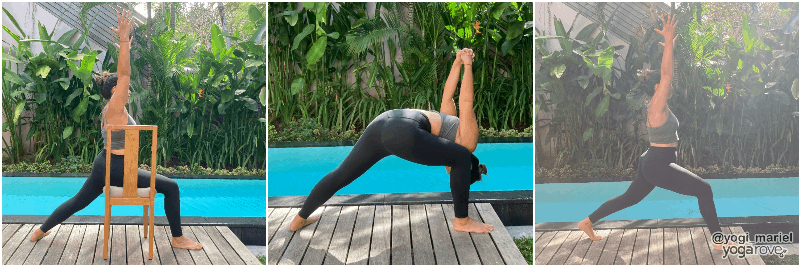
Use a chair: Yes, you can practice Warrior 1 on a chair! This variation is especially great if you find it a little challenging to balance or if you feel tightness in your body. Sit with the back of the chair touching your left arm and place both of your feet on the ground. Take your right leg back and root your foot down so that you are in a Warrior 1 stance with your legs. Lift your arms up overhead or rest your hands on the back of the chair for support.
Humble Warrior: This is a beautiful heart and hip opener. From your Warrior 1, interlace your fingers at your lower back. Inhale to lift your chest and as you exhale, bow forward to the inside of your knee. Move your hands away from your body, keep your legs strong, and relax your head. Stay for 3-5 breaths.
Crescent Lunge: While this is a pose on its own, it is very similar to Warrior 1. Instead of rooting your back heel to the mat, lift your heel up and stay on the ball of your back foot. You may have to take a longer stance. Square your hips to the front of the room. Keep your back leg strong and squeeze everything toward the midline of your body. Stay for 3-5 breaths.
Contraindications
If you are working with a hip, ankle, or knee injury, take caution in Warrior 1 and modify as needed. If you have any balance or high blood pressure issues, look forward instead of looking up and take it slow while you are in the posture.
Next time you are in Warrior 1 pose, connect to that feeling of strength, stability, and power in your body. Find that energy, and take it off your mat so that you are ready to conquer whatever life throws your way!


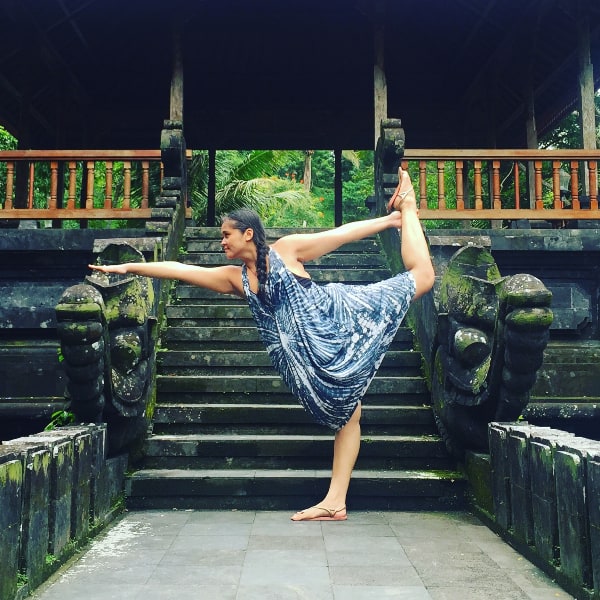

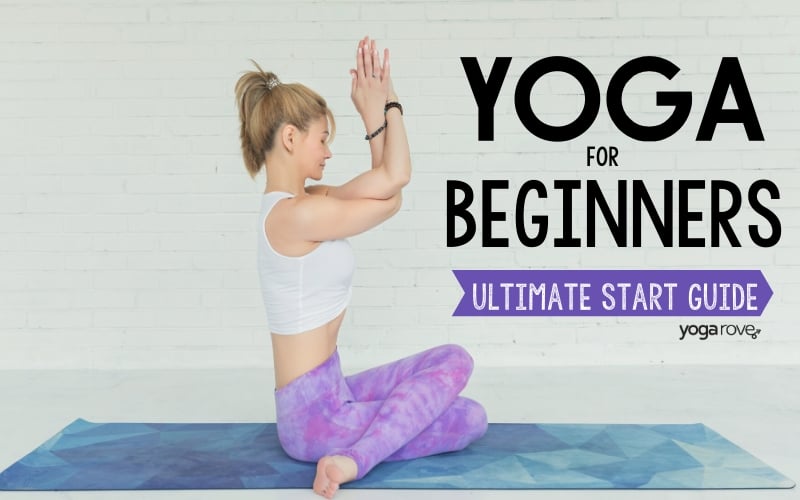


Thank you for taking the time to post, great information about Warrior 1
So glad you found it helpful Jodie!
Warrior pose is one pose i can say I can do and love the practice too.
jackie
Glad you enjoyed it Jackie 🙂 I love Warrior 1 as well!
I just stumbled upon your website when I was looking into the benefits of Yoga. I started my Yoga Journey last week, went to 3 classes thus far and I really love the calm feeling I get after the class is over and how I feel all throughout the day. So glad I found something that is helping me to relate to exercise in a whole different manner. Thanks for sharing your information!
We are truly glad you are enjoying all the information. Have a wonderful day!